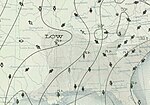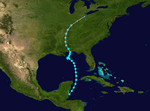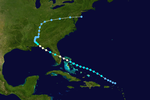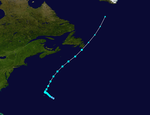1939 Atlantic hurricane season
| 1939 Atlantic hurricane season | |
|---|---|
 Season summary map | |
| Seasonal boundaries | |
| First system formed | June 12, 1939 |
| Last system dissipated | November 6, 1939 |
| Strongest storm | |
| Name |
|
| • Maximum winds | 130 mph (215 km/h) |
| Seasonal statistics | |
| Total storms | 5 |
| Hurricanes | 3 |
| Major hurricanes (Cat. 3+) | 1 |
| Total fatalities | 5 |
| Total damage | Unknown |
The 1939 Atlantic hurricane season officially began on June 16, 1939, and lasted until October 31, 1939.[1] These dates generally mark the period of each year when most tropical cyclones form in the Atlantic basin. The 1939 season was relatively inactive, with only five tropical storms, of which two became hurricanes and one became a major hurricane, equivalent to Category 3 status or higher on the modern-day Saffir-Simpson Hurricane Scale. The first tropical cyclone formed on June 12, and the last dissipated on November 6.
All of the storms impacted land to same extent. The first three cyclones of the season made landfall along the coast of the United States, collectively causing fairly minor damage. Hurricane Four, the strongest of the year, took a generally northeast path through the western Atlantic, striking Bermuda on October 16. The fifth and final storm was a minimal hurricane that wrought damage throughout the western Caribbean Sea, most notably in Jamaica and Cuba
Timeline

Storms
Tropical Storm One
| Tropical storm (SSHWS) | |
| Duration | June 12 – June 17 |
|---|---|
| Peak intensity | 50 mph (85 km/h) (1-min); 1000 mbar (hPa) |
The first tropical storm of the season developed in the extreme western Caribbean Sea on June 12.[2] Reports of the storm first came in through the Mexican Weather Service office in Chetumal, Quintana Roo, and during the afternoon of June 12, vessels just offshore recorded squally conditions and choppy seas.[3] The cyclone moved northward, parallel to the coast of Belize, before moving over the northeastern corner of the Yucatán Peninsula. It continued steadily northward through the Gulf of Mexico, slowly strengthening to a peak of 50 mph on June 14 with a minimum central pressure of 1,000.0 hectopascals (29.53 inHg).[2][3] An area of high pressure to the north caused it to execute a counter-clockwise loop. A trough of low pressure turned it back to the north, and the cyclone made landfall near Mobile, Alabama as a minimal tropical storm on June 16. Turning to the northwest, it quickly weakened to a tropical depression and dissipated on June 17 over Mississippi.[2]
In advance of the system, officials issued storm warnings for coastal areas of Alabama and western Florida, and residents in low-lying areas were advised to seek higher ground.[4] Damage in association with the cyclone was generally minor, and only one life was lost when a boy fell into the swollen waters of a river and drowned.[3]
Hurricane Two
| Category 1 hurricane (SSHWS) | |
| Duration | August 7 – August 20 |
|---|---|
| Peak intensity | 80 mph (130 km/h) (1-min); 991 mbar (hPa) |
On August 7, a tropical storm formed north of the Leeward Islands, likely from a tropical wave.[2] It tracked to the west-northwest, slowly strengthening as it moved through the Bahamas to a hurricane on August 11. Later that day, it crossed the east coast of Florida, and crossed the state in around 15 hours. After weakening to a tropical storm, it quickly re-strengthened upon emerging into the Gulf of Mexico, and made another landfall near Apalachicola, Florida on August 13. Over land, the cyclone slowed considerably and quickly deteriorated.[3] On August 14, the storm weakened to a tropical depression as it drifted through Alabama. The depression turned to the northeast, and remained a tropical depression until it dissipated over New York on August 20.[2] Due to timely reports and warnings, the storm was reportedly forecast with "exceptional accuracy".[3]
In Florida, damage was minor, amounting to uprooted trees, broken windows, moderate crop damage, and downed power lines. A few flimsy structures and small watercraft also sustained damage. Along the Florida Panhandle, the storm's winds impacted power, telephone, and telegraph lines, and inflicted $2,000 worth of damage to a dock warehouse. A man in Cedar Key, Florida drowned after rough surf overturned his rowboat,[3] and at least two others suffered minor storm-related injuries.[5] As a result of the storm's slow forward movement, torrential rain fell in Alabama leading to severe flooding. Further inland, the storm apparently spawned a tornado in North Carolina which caused one death. As the depression continued heading inland, it dropped heavy precipitation throughout the Mid-Atlantic States, exceeding 14 in (360 mm) in Tuckerton, New Jersey.[3]
Tropical Storm Three
| Tropical storm (SSHWS) | |
| Duration | September 23 – September 26 |
|---|---|
| Peak intensity | 45 mph (75 km/h) (1-min); 1003 mbar (hPa) |
An area of disturbed weather over Central America organized into a tropical storm in the Bay of Campeche on September 23. Uneventfully, it moved generally north-northeastward through the Gulf of Mexico and strengthen to a peak with winds of 45 mph. The storm made landfall on south-central Louisiana on September 26, and dissipated later that day. The Weather Bureau office in New Orleans posted numerous advisories, although the effects from the storm were minimal.[3]
Hurricane Four
| Category 4 hurricane (SSHWS) | |
| Duration | October 12 – October 18 |
|---|---|
| Peak intensity | 130 mph (215 km/h) (1-min); 953 mbar (hPa) |
On the afternoon of October 9, reports from the Leeward Islands of low pressures and unsettled weather indicated that a storm was forming in the vicinity.[2] The disturbance strengthened into a tropical storm on October 12 to the northeast of Puerto Rico. The storm, beginning to quickly strengthen, tracked northwestward before turning towards the northeast due to a high pressure area building in from the west.[3] Early on October 15, it attained hurricane intensity and continued to mature until October 16, when it reached its peak at a strength corresponding to Category 4 status on the modern-day Saffir-Simpson Hurricane Scale.[2] That same day it passed just east of Bermuda. It weakened as it accelerated to the northeast, and became extratropical near Newfoundland a couple days later.[2][3]
Numerous ships encountered the hurricane along its course. On the President Harding, en route to New York, one crew member drowned due to the rough conditions and 73 crew and passengers suffered injury, of various severity, requiring a call for emergency medical supplies.[3] The ship itself sustained a bit of damage. As the storm passed near the island of Bermuda, it generated strong winds—gusting to 131 mph (211 km/h)—and heavy precipitation.[6] Damage was fairly significant; the winds uprooted trees, shattered windows, and disrupted public utilities.[7]
Hurricane Five
| Category 1 hurricane (SSHWS) | |
| Duration | October 29 – November 6 |
|---|---|
| Peak intensity | 90 mph (150 km/h) (1-min); >990 mbar (hPa) |
On October 29, the fifth and final known tropical cyclone of the season developed in the western Caribbean Sea from a tropical wave. It initially moved northwestward, but turned toward the east shortly thereafter. Drifting due eastward, the storm grew into a minimal hurricane on October 31 while passing over the Cayman Islands. The hurricane's center passed just north of the island of Jamaica later that day as it weakened back into a tropical storm. Eventually, the storm turned abruptly northeastward and crossed the eastern tip of Cuba. By November 3, it had emerged into the Atlantic and entered the southern Bahamas. Beginning to accelerate, the tropical storm passed to the west of Bermuda before becoming extratropical on November 6.[2][3]
At Grand Cayman, winds from the storm reached 92 mph (148 km/h) with a minimum pressure of 990.0 hectopascals (29.23 inHg). According to press reports, the hurricane inflicted considerable damage on the Cayman Islands. In northern Jamaica, property damage was also widespread. The hurricane brought heavy rainfall, high winds, and pounding surf to the island, leaving one dead. In Cuba, where another death was reported, torrential rains caused extensive flooding and losses to livestock and crops.[3]
See also
References
- ^ "Gull Section Beats Hurricanes to Punch With 'Tip-Off' System Warning in Advance". The Daily Capital News. June 15, 2009. Retrieved December 7, 2009.
{{cite web}}: Italic or bold markup not allowed in:|publisher=(help) - ^ a b c d e f g h i Atlantic hurricane research division (2009). "Atlantic hurricane database (HURDAT) "best track" (1851–2008)". National Oceanic and Atmospheric Administrations. Retrieved December 6, 2009.
- ^ a b c d e f g h i j k l m Jean Galleen (1939). "North Atlantic Tropical Disturbances of 1939" (PDF). Weather Bureau. Retrieved December 6, 2009.
- ^ "Gale Winds Expected Along Florida Coast". The Daily Capital News. June 15, 2009. Retrieved December 6, 2009.
{{cite web}}: Italic or bold markup not allowed in:|publisher=(help) - ^ "Hurricane Passes Over Florida Tip". The Gallup Independent. August 12, 2009. Retrieved December 7, 2009.
{{cite web}}: Italic or bold markup not allowed in:|publisher=(help) - ^ Bermuda Weather Service (2007). "Hurricanes - General Information for Bermuda". Retrieved December 7, 2009.
- ^ "Bermuda Hurricane Rips Up Trees, Halts Utilities". The Chicago Daily Tribune. October 18, 1939.
{{cite news}}:|access-date=requires|url=(help); Italic or bold markup not allowed in:|publisher=(help)








